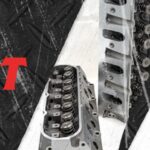Part of being a responsible car owner involves proactive maintenance. However, navigating the world of car mechanics and understanding all the key components can feel overwhelming when you’re trying to make informed repair decisions.
One thing is certain: knowing which car parts can become dangerous if they malfunction, and which are relatively inexpensive to maintain, is crucial.
Understanding your car’s parts is key to keeping them well-maintained and managing associated costs.
Let’s explore the inner workings of a car, from pistons to spark plugs, and understand the essential components that make up the anatomy of any vehicle. This guide will help you familiarize yourself with common car parts names and their functions.
Engine Components: The Heart of Your Car
Keeping your engine in top condition preserves your car’s value and minimizes running costs. Knowing the names of car engine parts is the first step to maintenance.
Cylinder Block and Pistons
The engine’s cylinder block is a robust structure, serving as the foundation of the powerhouse. It houses individual cylinders – hollow tubes where controlled combustion takes place.
Pistons, secured by piston rings within these cylinders, move up and down. They are vital for converting the explosive energy from combustion into a driving force, propelling the vehicle forward. The piston-cylinder interaction is fundamental, making it the primary component responsible for generating automotive power. Understanding the function of pistons and cylinders is crucial when learning car parts names.
Crankshaft and Camshaft
Deep within the engine’s workings are the crankshaft and camshaft. The crankshaft converts the pistons’ vertical motion into rotational energy, providing the drive for the vehicle.
Simultaneously, the camshaft precisely manages valve opening timing, ensuring smooth combustion. Together, they synchronize internal combustion events with accurate movements, contributing to the car’s smooth and propulsive motion. Recognizing these car parts names and their roles is essential for engine comprehension.
Intake and Exhaust Manifolds
Think of these vital components as the car’s lungs, managing airflow. The intake manifold draws in oxygen for combustion, while the exhaust manifold expels spent gases through the exhaust system.
Together, they optimize the internal combustion engine’s performance, ensuring a harmonious balance of power and efficiency. It’s important to note that electric vehicles do not have intake and exhaust manifolds, highlighting a key difference in car parts names between engine types.
Powertrain and Gearboxes: Transferring Power to Motion
The gearbox, a critical part in manual cars, should operate smoothly and be treated with care. Understanding car gearbox parts names can aid in proper maintenance.
Different Types of Gearboxes (Transmission)
Manual Gearboxes
Manual gearboxes put the driver in control of the car’s gears.
Requiring manual engagement and disengagement of gears using a clutch, these gearboxes allow drivers to constantly respond to driving conditions like road slipperiness, acceleration, and deceleration. For drivers who prefer more control, understanding manual gearbox car parts names is beneficial.
Automatic Gearboxes
Automatic gearboxes simplify driving by smoothly shifting gears without driver intervention. Gears change automatically, eliminating the need for a clutch or gear stick.
Inside these gearboxes, a torque converter, a fluid coupling, manages gear changes seamlessly. Automatic gearboxes are a complex system with many internal car parts names to learn.
CVTs (Continuously Variable Transmissions)
Continuously Variable Transmissions (CVTs) represent the most advanced gearbox mechanics. Using pulleys and belts, CVTs offer an infinite range of gear ratios, resulting in seamless and continuous acceleration.
This design not only optimizes fuel efficiency but also dynamically adapts to changing driving conditions, making CVTs a high-performance choice. While the internal car parts names of a CVT may differ, the function remains transmission of power.
Differential and Driveshaft
In a car’s power system, the differential and driveshaft work in concert but perform distinct tasks. The driveshaft transmits power from the transmission to the wheels.
Meanwhile, the differential ensures power is evenly distributed to the wheels, enabling smooth turns. Together, they create a harmonious system for your car’s motion. Knowing the car parts names like differential and driveshaft helps understand power distribution.
Clutch and Torque Converter
In the world of gears and transmission, the clutch and torque converter play crucial roles. In manual transmissions, the clutch assists the driver in engaging and disengaging gears for precise control.
In automatic transmissions, the torque converter smoothly transfers power, ensuring seamless gear shifts, making your drive both smooth and dynamic. These are essential car parts names to differentiate between manual and automatic transmissions.
Fuel and Ignition Systems: Powering the Combustion
Your internal combustion engine car’s fuel system is absolutely vital – and must be in optimal working order to prevent dangerous breakdowns. Familiarize yourself with car fuel system parts names for proactive maintenance.
Fuel Injection System
A key component of modern engines, the fuel injection system ensures optimal combustion. Fuel injectors precisely deliver fuel into the engine cylinders, enhancing efficiency and power.
This technology replaced carburettors, which were prone to breakdowns due to clogging and wear. Fuel injectors offer better fuel distribution, improved performance, and reduced emissions. Understanding the advancements from carburettors to fuel injectors helps appreciate the evolution of car parts names and technology.
Spark Plugs and Ignition Coils
The ignition system comprises spark plugs and ignition coils. They work together to ignite the engine’s fuel-air mixture. The spark plug generates the spark needed for combustion, while ignition coils amplify the voltage.
These two parts must be synchronized to ensure efficient and rapid ignition, which is crucial for optimal engine performance, responsiveness, and fuel efficiency. Spark plugs are among the commonly replaced car parts names in routine maintenance.
Throttle Body and Air Intake System
The throttle body and air intake system collaborate to manage airflow into the engine. The throttle controls the amount of air entering the engine, and the air intake system ensures a clean and efficient air supply.
Working together, they oversee the engine’s ‘breathing’ – a critical aspect for achieving peak power, fuel efficiency, and overall performance. These car parts names are important for understanding engine air management.
Cooling and Lubrication: Maintaining Optimal Temperatures
Radiator and Cooling Fans
The radiator and cooling fans are the primary defenses against internal combustion engine overheating.
The radiator dissipates heat from the coolant, while the cooling system enhances airflow, expelling excess heat. These two parts ensure the engine maintains an optimal temperature, preventing damage and promoting efficient performance. Recognizing these car cooling system parts names is vital for preventing overheating.
Water Pump and Hoses
Two more cooling system components crucial for regulating engine temperature are the water pump and hoses. The water pump circulates coolant, absorbing heat, while hoses allow the coolant to move throughout the system.
Together, they ensure consistent coolant flow, which is essential for temperature regulation. Water pumps and hoses are key car parts names in the coolant circulation system.
EV Battery Cooler System
Electric vehicles utilize a different cooling system, focused on cooling the battery and electric motor. The battery cooler, similar to a traditional radiator, dissipates heat from the battery coolant, while the cooling system enhances airflow to expel excess heat.
In EVs, maintaining optimal temperature is vital for battery and electric motor longevity and efficiency. Understanding car parts names in EV cooling systems is increasingly important.
Oil Pump and Oil Filter
The oil pump circulates engine oil, ensuring components remain well-lubricated for smooth operation. Simultaneously, the oil filter removes impurities, preserving engine health. Together, they extend the engine’s lifespan.
Regular oil changes and filter replacements are crucial maintenance tasks involving these car parts names.
Electrical System: Powering Everything Else
Your car’s electrical system is central to everything, from the engine to the accessories. Knowing car electrical parts names can help diagnose electrical issues.
Battery
The car battery is the vehicle’s initial energy source, starting the engine and powering electrical functions. All cars have batteries, not just EVs. Battery faults or capacity loss will necessitate replacement.
The battery is a fundamental car part name in any vehicle.
Alternator
The alternator converts mechanical energy from the engine’s rotation into electrical energy. This recharges the battery and powers the car’s electrical system while the engine is running.
Importantly, the alternator regulates voltage to maintain a consistent electrical supply, preventing battery overcharging and ensuring electrical components receive the correct power. The alternator is a critical car part name for maintaining electrical power.
Starter Motor and Solenoid
The starter motor and solenoid work together to start the engine. The solenoid activates the starter motor, which turns the engine to initiate the combustion process.
This coordinated effort transforms electrical energy into mechanical motion. These car parts names are essential for engine ignition.
Wiring Harness and Fuses
The wiring harness channels electricity throughout the vehicle, connecting various components. Fuses, strategically placed, protect against electrical overloads.
Together, they ensure a safe and organized flow of electrical power, preventing potential malfunctions and safeguarding the entire electrical network. Understanding the wiring harness and fuses is important for electrical system troubleshooting, and knowing these car parts names is helpful.
Suspension and Steering: Ensuring a Smooth Ride
Smooth and easy maneuverability requires a lot of work from the suspension and steering systems. Power steering systems are made up of several sensitive components. Learning car suspension parts names and car steering parts names can improve your understanding of vehicle handling.
Shock Absorbers and Struts
Shock absorbers and struts are essential components in a car’s suspension system. Shock absorbers, typically four per car, absorb shocks and vibrations, providing a smoother ride by managing vertical movements near the wheels.
Struts, often located at the front and sometimes rear, offer both structural support and shock absorption, contributing to vehicle stability. Together, they enhance driving comfort by dampening the impact of bumps and uneven road surfaces, ensuring a more stable and enjoyable ride. These are fundamental car parts names for ride comfort and handling.
Control Arms and Bushings
In the chassis, control arms and bushings provide stability and smooth handling. Control arms connect the suspension to the frame, while bushings provide flexibility.
This duo absorbs road imperfections, maintains tire alignment, and ensures a balanced ride. Control arms and bushings are important car parts names for suspension system integrity.
Power Steering Pump and Rack
These parts are key for responsive steering. The pump generates hydraulic pressure, while the rack converts it into controlled motion, making steering effortless.
Together, they provide precise and smooth maneuverability, for ease of navigation on the road. Power steering pumps and racks are key car parts names for effortless steering.
Braking System: Safety First
The braking system is a finely-tuned area of your vehicle. Brake system parts are rigorously tested annually to ensure road safety. Knowing car braking system parts names is vital for safety.
Brake Pads
These frictional components, usually made of composite materials, press against the brake rotors, converting kinetic energy into heat and facilitating controlled deceleration.
Their robust design ensures reliable braking performance when the brake pedal is applied, contributing to both safety and the longevity of the braking system. Brake pads are wear items, and knowing these car parts names helps understand maintenance needs.
Brake Calipers
Brake calipers are positioned around the brake rotor and house pistons. Upon receiving hydraulic pressure, these pistons clamp the brake pads onto the rotor, generating the necessary friction for controlled deceleration. Their precision ensures responsive and reliable braking, contributing significantly to driving safety. Brake calipers are crucial car parts names for braking force application.
Exhaust System: Managing Emissions and Noise
Your car’s exhaust system is just as important as any other. Ensuring your car runs cleanly and emits minimal pollutants requires keeping your exhaust parts in good condition. Understanding car exhaust system parts names is important for environmental responsibility.
Catalytic Converter
The catalytic converter in an internal combustion engine transforms harmful gases like carbon monoxide into less harmful substances through catalysis.
This ingenious device reduces vehicle emissions, contributing to cleaner air and environmental health, making it a key component in compliant automotive systems. The catalytic converter is a vital car part name for emissions control.
Muffler and Resonator
The muffler and resonator work together in a car’s exhaust system to manage noise levels. The muffler primarily reduces noise, while the resonator fine-tunes sound frequencies, adjusting the exhaust notes.
A driver’s ability to hear how the car is running enhances adaptive driving and driving enjoyment. Mufflers and resonators are important car parts names for noise reduction and sound quality.
Oxygen Sensors
Oxygen sensors monitor oxygen levels in the exhaust gases, providing crucial data to the engine control unit. This information enables precise fuel injection, optimizing combustion efficiency and reducing emissions.
Oxygen sensors are key car parts names for engine efficiency and emissions control.
Interior Components: Comfort and Convenience
Your car’s interior furnishings are relatively inexpensive and easy to repair or replace before selling, and can significantly impact your car’s resale value, as the interior contributes to the driver’s perception of pristine condition. Familiarizing yourself with car interior parts names can help maintain your car’s value.
Seats & Seat Belts
Seats are designed for comfort and support, available in various materials and configurations. Seat belts, essential for safety, secure occupants during travel, often equipped with pretensioners and force limiters.
Seats and seat belts are fundamental car parts names for occupant safety and comfort.
Dashboard & Steering Functions
The dashboard serves as a visual command center, displaying essential information like speed, fuel levels, and engine status. It provides a comprehensive snapshot, ensuring driver awareness.
Paired with the steering wheel, which includes power-assisted features and controls for indicators, wipers, and multimedia systems, the dashboard and steering wheel are central to driver control and information, and knowing their associated car parts names is helpful.
Exterior Components: Style and Protection
Your car’s exterior can be prone to scratches and minor bumps, making your car look worn. Fixing these imperfections before selling can be cost-effective to maximize your selling price. Understanding car exterior parts names aids in maintaining your vehicle’s appearance.
Features & Controls on Doors
Door features and controls are integral components enhancing driver convenience and safety. Most cars include electric window controls, door locks, and mirror adjustments.
Some models also incorporate advanced features like keyless entry and power-operated doors, contributing to a more streamlined and user-friendly driving experience. These door features are common car parts names drivers interact with daily.
Wheels and Tyres: Connecting to the Road
Types of Tyres and Their Functions
| Type of Tyre | Function |
|---|---|
| Summer Tyres | Designed for warm weather, excelling in dry and wet conditions with optimal grip and precise handling. |
| Winter Tyres | Engineered for cold climates, featuring specialized treads for improved traction on snow and ice-covered roads. |
| All-Season Tyres | Versatile performers suitable for various conditions, balancing traction and durability in both wet and dry weather. |
| Performance Tyres | Designed for sportier driving, prioritizing handling, grip, and responsiveness at higher speeds. |
| Off-Road Tyres | Built for challenging terrains, featuring rugged treads and reinforced sidewalls for enhanced traction and durability. |
| Run-Flat Tyres | Equipped with reinforced sidewalls, allowing continued driving at reduced speeds for a limited distance after a puncture. |
| Touring Tyres | Focused on a smooth and comfortable ride, ideal for long-distance journeys with low road noise and good handling. |
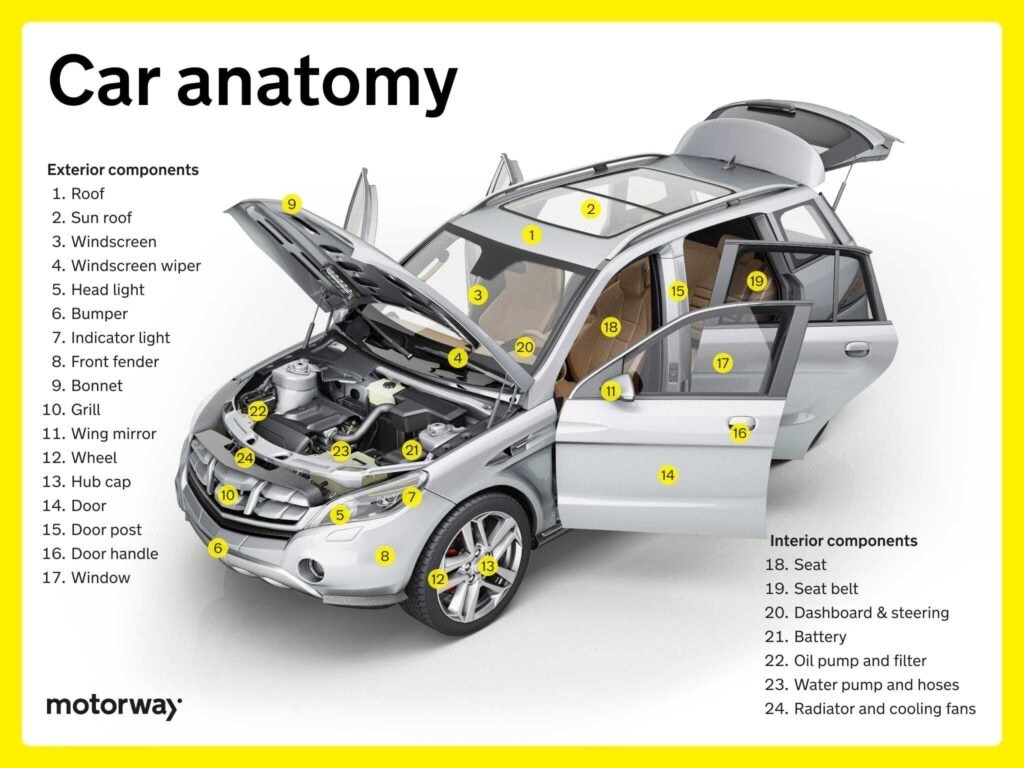
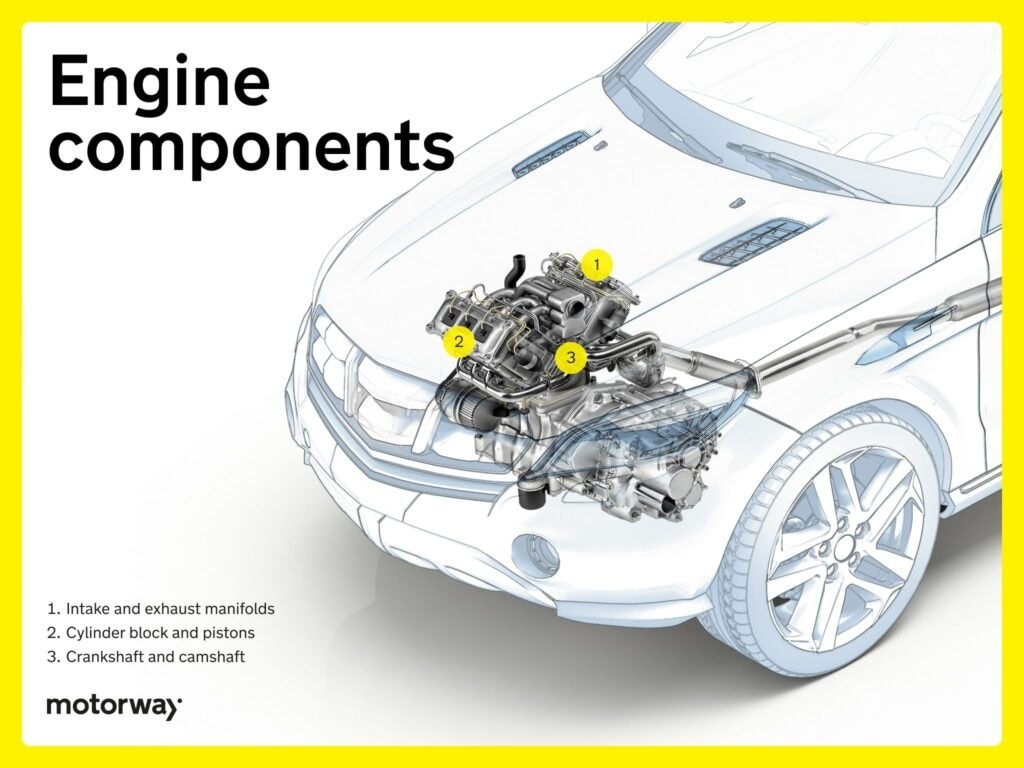
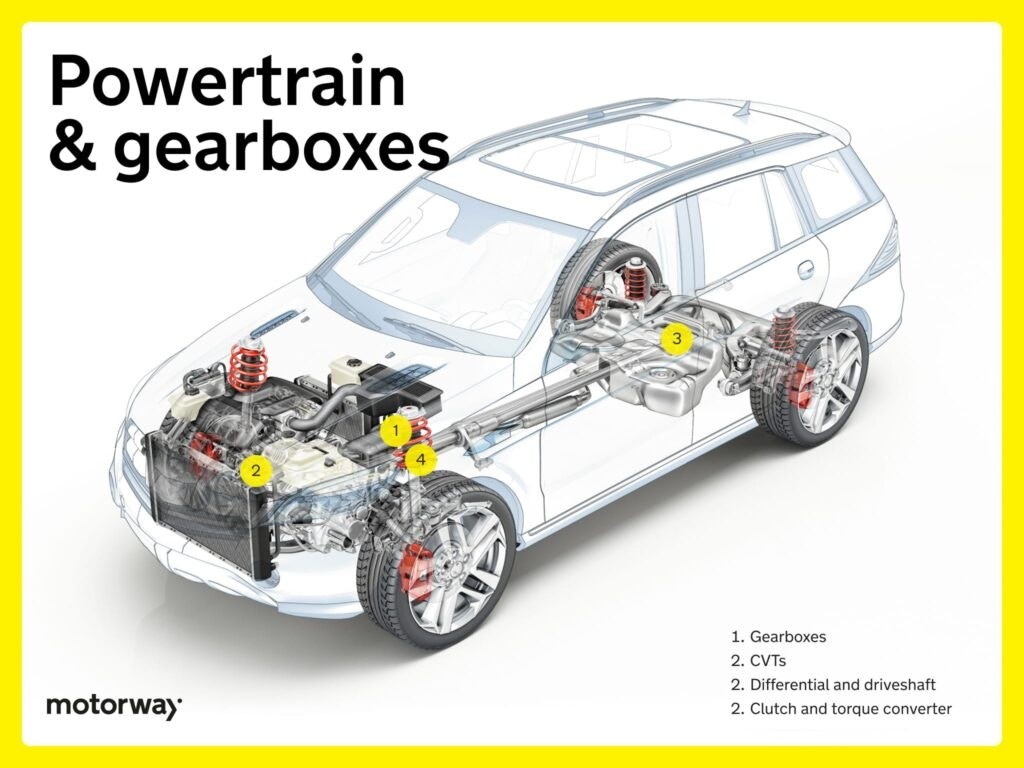
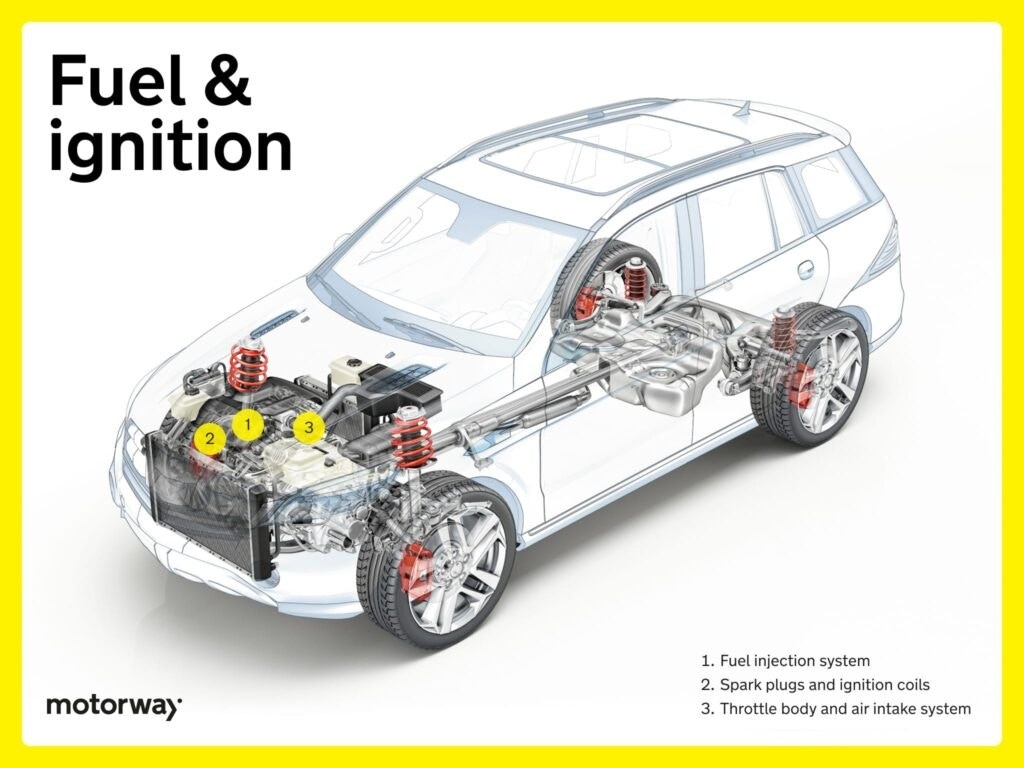
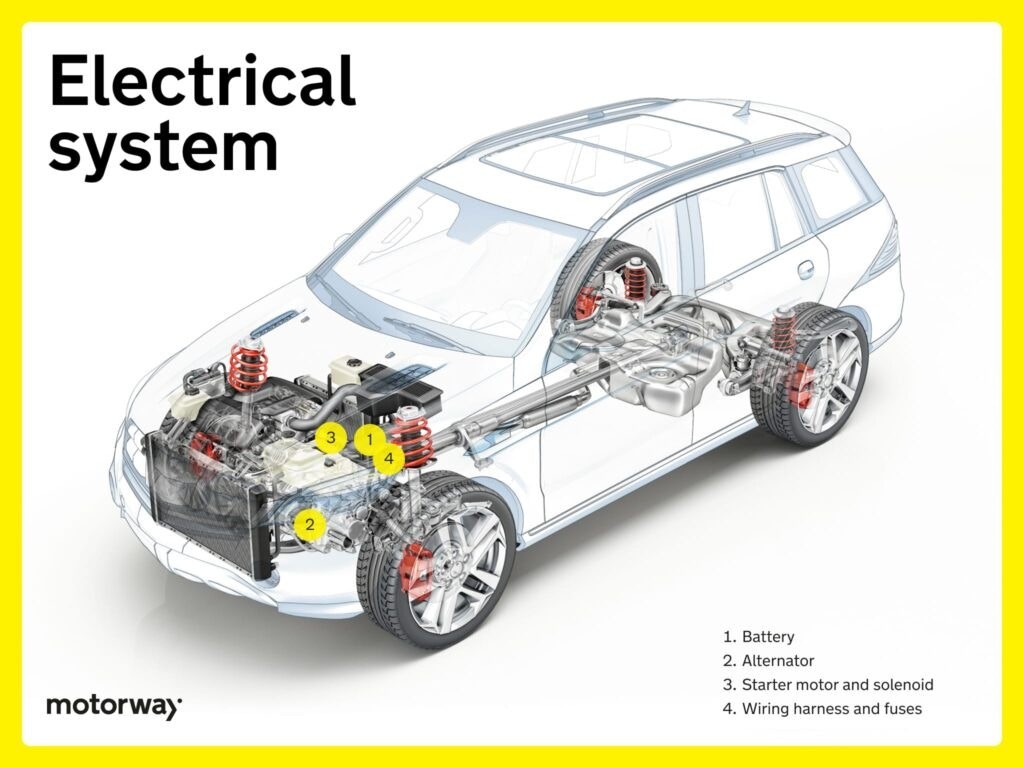
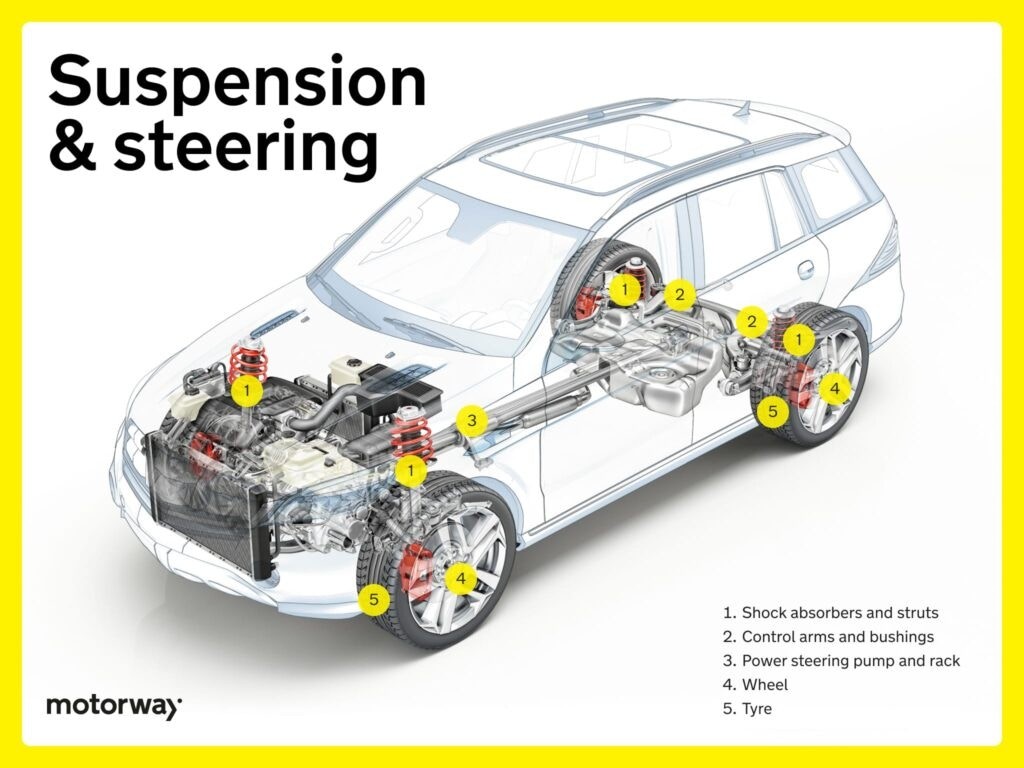
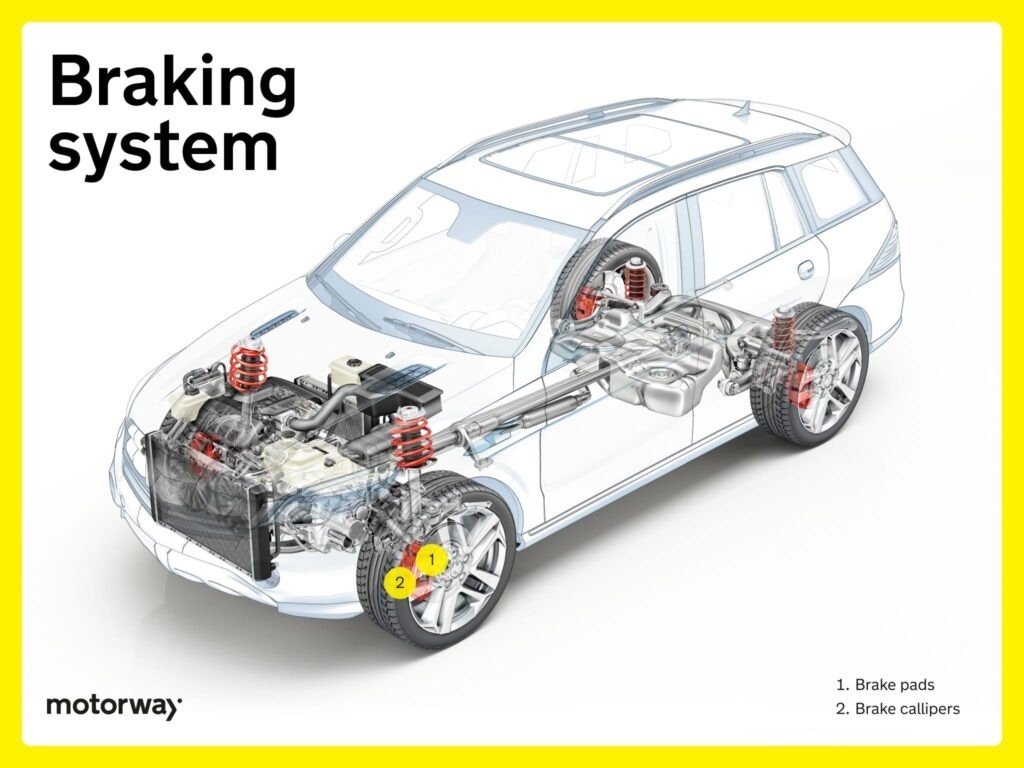
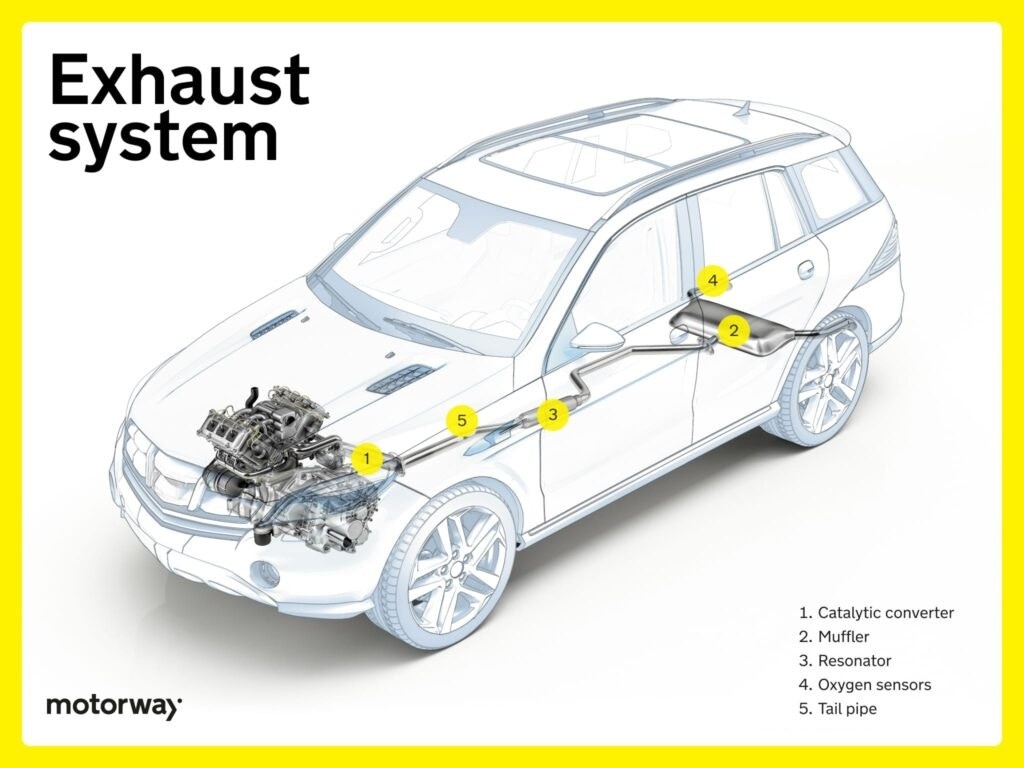
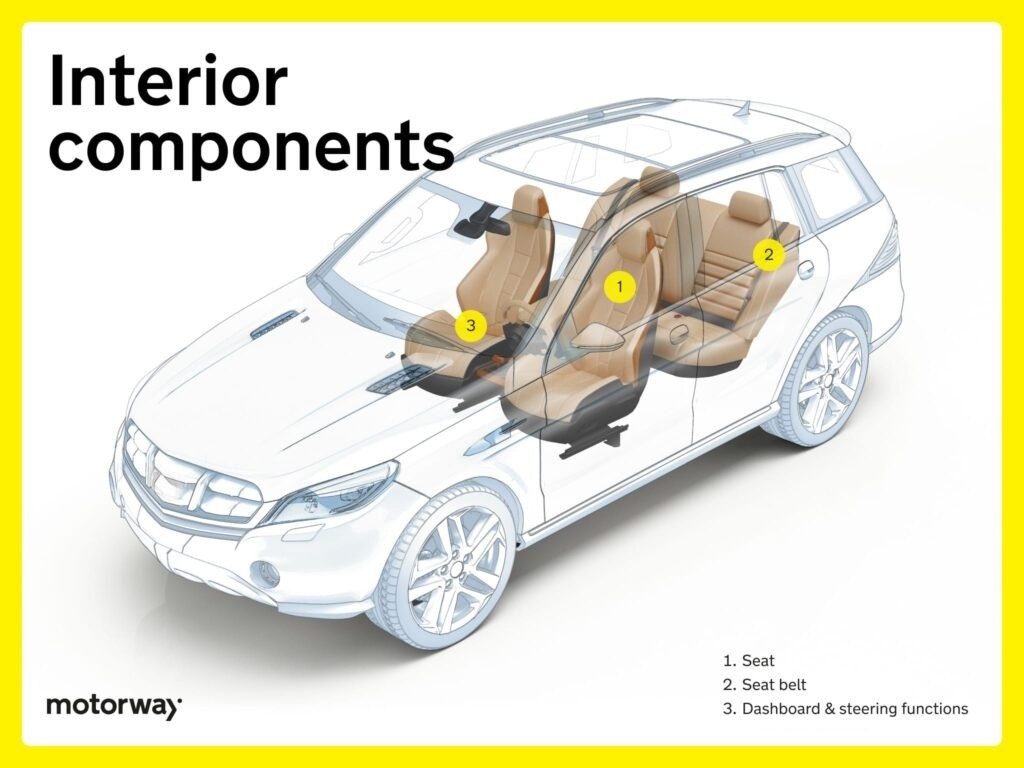
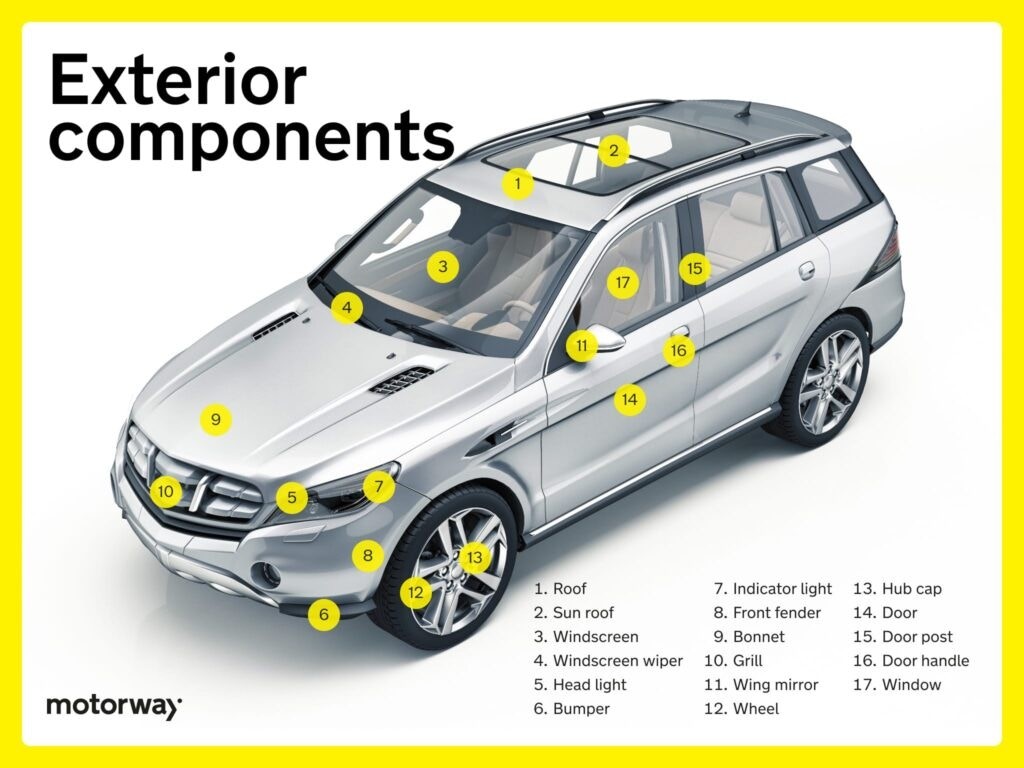
Understanding different tyre types and their functions expands your knowledge of car parts names related to wheels.
Wheel Construction Guide: Alloy vs. Steel Wheels
Wheel construction involves several designs:
- One-piece construction: The entire wheel is made from a single piece of material, typically alloy or steel, common for both types of wheels.
- Two-piece construction: The wheel comprises two main parts – the center and the outer rim, usually bolted or welded together, often found in performance or custom wheels.
- Three-piece construction: The wheel consists of three separate pieces – the center, outer rim, and inner hoop. This modular design allows for greater customization, popular in the aftermarket scene.
- Forged construction: Forged wheels are made from compressed metal, resulting in stronger and lighter wheels compared to cast wheels, often used in high-performance and racing.
- Multi-piece construction: This design combines multiple components, offering versatility in sizing and customization.
The choice of wheel construction affects weight, durability, and aesthetics, allowing drivers to select wheels matching their performance and style preferences. Material choices include:
- Alloy wheels: Made from metal mixtures, often aluminum or magnesium. They are lightweight, improve heat dissipation, and enhance vehicle appearance.
- Steel wheels: Made from steel, ensuring robustness. Heavier than alloy wheels but durable, cost-effective, and suitable for rugged driving.
Understanding wheel construction and materials adds to your knowledge of car parts names.
Tyre Pressure Monitoring System (TPMS)
The TPMS is a safety feature that continuously monitors tyre air pressure using sensors in each tyre. It transmits real-time data to the vehicle’s computer and warns if pressure deviates from optimal levels. This enhances safety, fuel efficiency, and extends tyre lifespan by ensuring proper inflation. TPMS is an important safety-related car part name.
FAQs About Car Parts
What parts are under a car?
Under a car, you’ll find crucial components like the engine, transmission, suspension system, exhaust system, and fuel system, all working together for proper vehicle functionality and performance. These are some of the major car parts names located underneath the vehicle.
How many car parts are on a car?
The number of car parts varies, but modern vehicles can have over 30,000 individual parts, encompassing various systems and components, highlighting the intricate engineering and complexity of car design. EVs typically have fewer parts due to simpler engines relying on batteries instead of mechanical parts. This emphasizes the vast number of car parts names in a typical vehicle.
What are the important parts of a vehicle?
Important vehicle parts include the engine, transmission, brake system, steering system, suspension, and electrical components, each playing a vital role in ensuring vehicle safety. These are some of the most critical car parts names for vehicle operation and safety.
What parts of a car can be sold separately?
Components like engines, transmissions, body parts, and specific electrical parts can be sold separately, depending on demand and availability, offering flexibility for repairs, replacements, or upgrades. Knowing which car parts names can be sold separately is useful for repairs or upgrades.
Why is there a shortage of car parts?
Car part shortages can arise from supply chain disruptions, increased demand for specific components, manufacturing challenges, and global events impacting production and distribution. This global issue affects the availability of many car parts names across the industry.
Need to Sell Your Car?
Want to learn more about owning, maintaining, and selling your car? Check out more of our guides here, covering everything from Clean Air Zones to car tax, and plate changes to part exchange.
